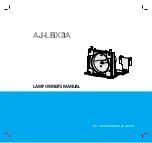
652
Inspections
Section 13-1
13-1 Inspections
Daily or periodic inspections are required in order to maintain the PLC’s func-
tions in peak operating condition.
13-1-1 Inspection Points
Although the major components in CP-series PLCs have an extremely long
life time, they can deteriorate under improper environmental conditions. Peri-
odic inspections are thus required to ensure that the required conditions are
being kept.
Inspection is recommended at least once every six months to a year, but more
frequent inspections will be necessary in adverse environments.
Take immediate steps to correct the situation if any of the conditions in the fol-
lowing table are not met.
No.
Item
Inspection
Criteria
Action
1
Source Power
Supply
Check for voltage fluctuations
at the power supply terminals.
The voltage must be within
the allowable voltage fluctu-
ation range.
(See note.)
Use a voltage tester to check the
power supply at the terminals. Take
necessary steps to bring voltage
fluctuations within limits.
2
I/O Power Sup-
ply
Check for voltage fluctuations
at the I/O terminals.
Voltages must be within
specifications for each Unit.
Use a voltage tester to check the
power supply at the terminals. Take
necessary steps to bring voltage
fluctuations within limits.
3
Ambient environ-
ment
Check the ambient tempera-
ture (inside the control panel if
the PLC is in a control panel).
0 to 55
°
C
Use a thermometer to check the
temperature and ensure that the
ambient temperature remains
within the allowed range of 0 to
55
°
C.
Check the ambient humidity
(inside the control panel if the
PLC is in a control panel).
Relative humidity must be
10% to 90% with no con-
densation.
Use a hygrometer to check the
humidity and ensure that the ambi-
ent humidity remains within the
allowed range.
Check that the PLC is not in
direct sunlight.
Not in direct sunlight
Protect the PLC if necessary.
Check for accumulation of
dirt, dust, salt, metal filings,
etc.
No accumulation
Clean and protect the PLC if neces-
sary.
Check for water, oil, or chemi-
cal sprays hitting the PLC.
No spray on the PLC
Clean and protect the PLC if neces-
sary.
Check for corrosive or flam-
mable gases in the area of the
PLC.
No corrosive or flammable
gases
Check by smell or use a sensor.
Check the level of vibration or
shock.
Vibration and shock must
be within specifications.
Install cushioning or shock absorb-
ing equipment if necessary.
Check for noise sources near
the PLC.
No significant noise
sources
Either separate the PLC and noise
source or protect the PLC.
Summary of Contents for CP1L-EL20DR-D
Page 3: ...CP1L EL20D CP1L EM30D CP1L EM40D CP1L EL EM CPU Unit Operation Manual Produced July 2017...
Page 4: ...iv...
Page 10: ...x...
Page 22: ...xxii...
Page 34: ...xxxiv Software Licenses and Copyrights 7...
Page 192: ...158 Trial Operation and Debugging Section 5 3...
Page 250: ...216 Automatic Clock Adjustment and Specifying Servers by Host Name Section 6 7...
Page 666: ...632 Trouble Shooting Section 11 7...
Page 696: ...662 Standard Models Appendix A...
Page 805: ...771 Connections to Serial Communications Option Boards Appendix F Connecting to Unit...
Page 806: ...772 Connections to Serial Communications Option Boards Appendix F...
Page 836: ...802 PLC Setup Appendix G...
Page 838: ...804 TCP Status Transitions Appendix H...
Page 840: ...806 Ethernet Network Parameters Appendix I...
Page 842: ...808 Buffer Configuration CP1L EL EM Appendix J...
Page 844: ...810 Ethernet Specifications Appendix K...
Page 851: ...Index 817 work words 118 write protection 447...
Page 852: ...818 Index...
Page 854: ...820 Revision History...
Page 855: ......
















































